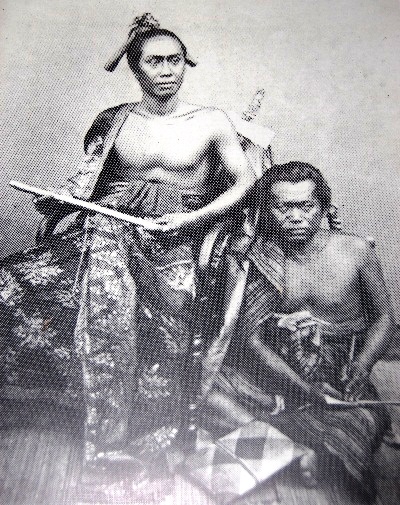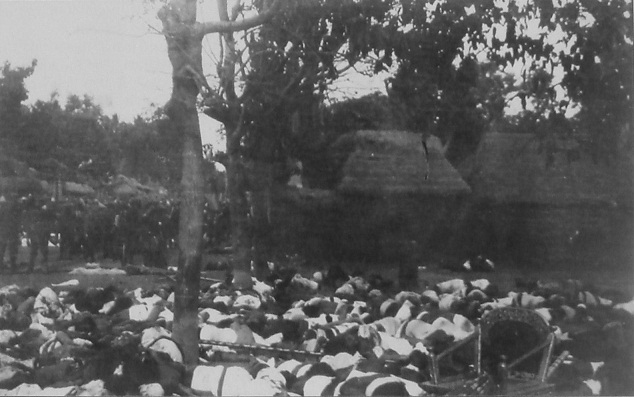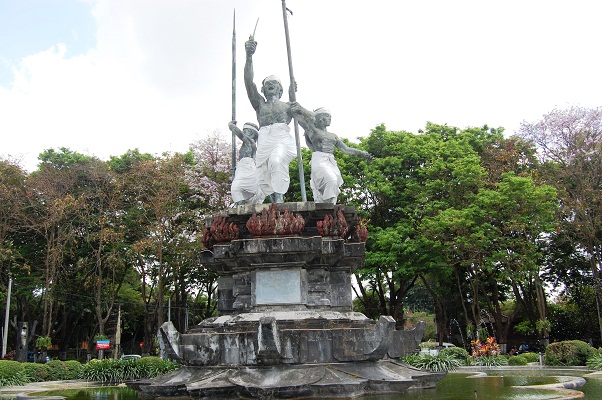|
Page < 1 2 3 4 5 6 7 8 9 10 11 12 13 14 15 16 17 18 19 20 21 22 23 24 >
Slaughter of Balinese Hindus
by the Dutch 
Dharma vs. Adharma in Bali
On May 27,
1905, a Chinese steamer was shipwrecked on the beach of Sanur about four miles
from Badung. The Balinese looted the wreckage, as they had done for centuries,
but the Dutch Government claimed an indemnity of 75 hundred florins from the
Rajah of Badung. He considered such a
request an insult and refused to pay.
This was the
excuse the Dutch were waiting for, and in 2906 they sent an expeditionary force
into South Bali. Surrounded on all sides by Dutch troops, the defenders, seeing
that their cause was lost, decided to die honorably rather than surrender.
In September 1906, the Dutch launched one of the most shameful and gruesome
episodes in colonial history.
During
the night of September 20, the Prince set fire to the Palace and the next
morning opened the gate. Thousands of Balinese advanced slowly towards the Dutch
guns. The men, sparkling with jewels, wore their ceremonial red, black and gold
costumes, while the women, carrying their children, wore pure white sarongs, and
were also covered with jewels and pearls. On a throne supported by the tallest
warriors, the Rajah, a slender young man, sat pale and silent. Suddenly, within
fifty yards of the Dutch, the Rajah drew his kris from its scabbard. This was
the signal, and the Balinese drew their swords. They shared a curious exaltation
at the thought of death. They dedicated themselves, and the sacrifice of their
bodies was but the shadow of reality. It was an offering to the gods in the age
old struggle between good and evil.
The Dutch Captain gave the order to fire and the
slaughter began.

Balinese Hindu Royalty -
Bajra Sandhi Monument. Bajra means a bell used by Balinese
priest. This monument is a memorial to the Balinese Struggle. The memorial was
opened by Megawati Sukarno Putri in 2003.
(image source:
webmaster's own collection of photos taken during a
recent visit).
***
The
Rajah fell and so did hundreds of his followers; wounded women stabbed their
babies for fear that they should survive, then husbands killed their wives. The
Balinese warriors and children brandishing spears and knives charged the firing
canons. Three times the Dutch ceased fire in attempt to stop the slaughter, but
the Balinese had decided to die.
The Dutch looted jewelry from the corpses and sacked the palace ruins.
European Imperialism - A Christian Enterprise was backed and blessed by the Pope
The Romanus Pontifex,
also issued by Pope Nicholas V in 1455,
sanctioned the seizure of non-Christian lands, and encouraged the enslavement of
non-Christian people.

Christian Love? A
gruesome massacre of Balinese Hindus by the Dutch Colonists.
Following the massacre
the Dutch looted the corpses and sacked the palace ruins.
(image source:
wikipedia.com).
***
Apart
from a few babies there were no survivors of the massacre. This was the end –
the Dutch were now the masters of all Bali. A similar scene was repeated at the
smaller court of Pemecutan in Denpasar. If the Dutch had hoped that events would
end there, they were mistaken.
Puputan – a ritual suicide meaning end of a kingdom.
Kshatriya honor
The
final act of Bali’s tragedy took place in 1908. The
King of Klungkung carrying his ancestral dagger, the kris, slowly
emerged from the palace. His court and more than 200
people accompanying him to face the Dutch. The King knelt down and a Dutch
bullet killed the king. His wives knelt around his corpse and drove keris blades
into their hearts while the others began the rite of Puputan. Klung
kung palace was razed. After nearly 600 years, the Balinese courts that had
descended from the Royal Majapahit Empire of Java
were gone.
Hindu Bali was now completely under the
control of the Dutch Colonists. Today, the Square in Den Pasar, the former
Badung, where it took place, has become a football ground.
Vedic India had
honorable rules in Warfare.
"The Hindu laws of war are very chivalrous and humane, and prohibit the slaying
of the unarmed, of women, of the old, and of the conquered."
European Imperialism
was a disgraceful and cruel chapter in Human History where Despicable Greed and
Arrogance were the principal factor in absence of rules in warfare.
***

The Puputan square in
Denpasar commemorates the last battle between the King of Badung and the Dutch
army in 1906.
The heroic sacrifice of
2000 Balinese Hindus that were killed by their own daggers or by the Dutch
bullets.
(image source:
webmaster's own collection of photos taken during a
recent visit).
***
In 1920 and in 1924, more permits were given to
Catholic and Protestant Missionaries
to carry on their work in Bali.
After
350 years of Imperialism, in 1945, a republic was proclaimed and the whole
archipelago took the name of Indonesia – Islands of
India.
(source: Lovers
in Paradise - By Barbara Cartland
and
Insight Guides: Java
and
Insight Guides: Bali and Lombok).
Top
of Page
Page < 1 2 3 4 5 6 7 8 9 10 11 12 13 14 15 16 17 18 19 20 21 22 23 24 >
|